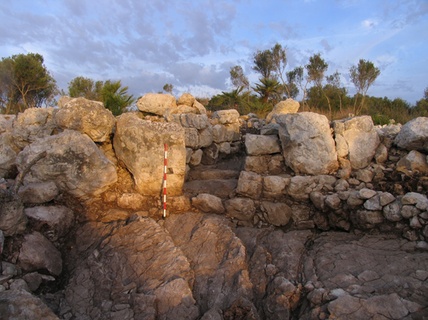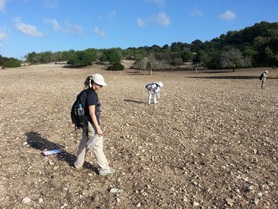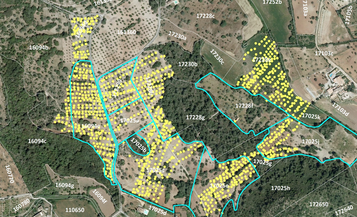2014 Campaign
 Front (L-R): Georgia Gilbert, Kayoung Kim, Jacob Corrado, Thao Tran, Victoria Wellington, Megan McCrea, Pere Rullan, Daisy Jaime, Sarah Croft; Back (L-R): Jordi Hernández, Dave Hunt, Marcos Llobera, Ana Fernández Dobao, Jake Deppen, Allison Skinner; Photo by Allison Skinner 2014
Front (L-R): Georgia Gilbert, Kayoung Kim, Jacob Corrado, Thao Tran, Victoria Wellington, Megan McCrea, Pere Rullan, Daisy Jaime, Sarah Croft; Back (L-R): Jordi Hernández, Dave Hunt, Marcos Llobera, Ana Fernández Dobao, Jake Deppen, Allison Skinner; Photo by Allison Skinner 2014
The 2014 campaign included continuing excavations at the site of Mestre Ramon as well as a pilot season of surface survey at other locations in the Son Servera municipality.
2014 marked the first year of UW involvement in the project. Dr. Marcos Llobera and PhD student Jake Deppen led a field school made up of ten UW undergraduates who joined with the Spanish team of Jordi Hernández, Toni Puig, Pere Rullan, and Bernat Burgaya. The project also benefited from the assistance of volunteers Wendy Hunt and Ana Fernández Dobao.
2014 marked the first year of UW involvement in the project. Dr. Marcos Llobera and PhD student Jake Deppen led a field school made up of ten UW undergraduates who joined with the Spanish team of Jordi Hernández, Toni Puig, Pere Rullan, and Bernat Burgaya. The project also benefited from the assistance of volunteers Wendy Hunt and Ana Fernández Dobao.
Excavation
 Photo by Jordi Hernández 2014
Photo by Jordi Hernández 2014
Dr. Antoni Puig and Dr. Jordi Hernandez began preliminary excavations at the site of Mestre Ramon in 2012 and continued in 2013 with teams of local and international volunteers. While the site was historically identified as one of the many "talaiots" (large stone towers) that are found in Mallorca and Menorca, the team's investigations have shown that it more closely resembles a structure known as a "stepped tumulus". Despite this name though, no evidence of burials has been found at Mestre Ramon.
The excavation portion of the 2014 campaign focused on two areas at the site of Mestre Ramon: 1) the southeast gate area of the outer wall and 2) the top of the stepped tumulus.
In the area of the gate, the team removed vegetation and rubble to expose the area leading up to the gate and the area just inside the entrance. On the exterior, the team was able to identify a previously undocumented wall extending from the main wall. Preliminary interpretations suggest that this auxiliary wall is contemporaneous with the construction of the gate and the main wall and may have served a defensive purpose. Because of the placement of the auxiliary wall, anyone approaching the gate would have had to do so directly; they would not have been able to reach the gate without being visible to those inside the gate.
The excavation portion of the 2014 campaign focused on two areas at the site of Mestre Ramon: 1) the southeast gate area of the outer wall and 2) the top of the stepped tumulus.
In the area of the gate, the team removed vegetation and rubble to expose the area leading up to the gate and the area just inside the entrance. On the exterior, the team was able to identify a previously undocumented wall extending from the main wall. Preliminary interpretations suggest that this auxiliary wall is contemporaneous with the construction of the gate and the main wall and may have served a defensive purpose. Because of the placement of the auxiliary wall, anyone approaching the gate would have had to do so directly; they would not have been able to reach the gate without being visible to those inside the gate.
Survey
 Photo by Marcos Llobera 2014
Photo by Marcos Llobera 2014
The survey portion of the research was focused on three main questions/goals:
- Testing a surface survey methodology
- How do surface assemblages at known sites differ from surface assemblages away from known sites?
- Are there sites in locations without monumental architecture?
- Reconstructing the use of the landscape through time through the collection of surface materials
 Surface survey collection points 2014
Surface survey collection points 2014
In 2014, the team collected over 4,300 ceramics from over 2,600 collection points. These ceramics were washed, dried, and given a preliminary identification in the field lab. Further laboratory analysis of each piece will document a series of physical attributes that relate to how, when, and where the original ceramic vessel was created and used.
Preliminary results of the survey suggest, not surprisingly, that known megalithic sites continued to be centers of activity long after their initial function was abandoned and even up to modern times. Additionally, while artifact densities are predictably lower away from known sites, some of these "off-site" areas contain evidence of significant occupations that have not been previously documented. Of particular note is a very strong concentration of pottery from the Islamic period as this period is still not well understood in Mallorca.
Preliminary results of the survey suggest, not surprisingly, that known megalithic sites continued to be centers of activity long after their initial function was abandoned and even up to modern times. Additionally, while artifact densities are predictably lower away from known sites, some of these "off-site" areas contain evidence of significant occupations that have not been previously documented. Of particular note is a very strong concentration of pottery from the Islamic period as this period is still not well understood in Mallorca.

